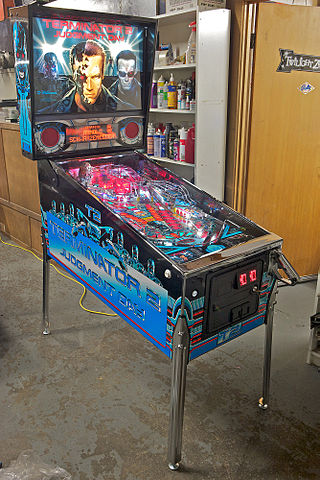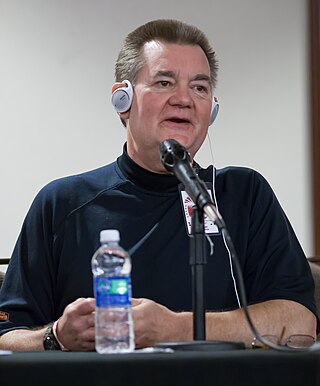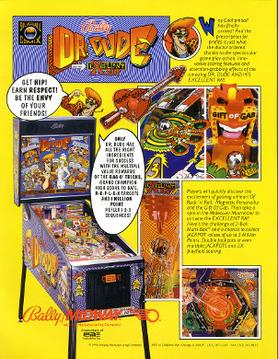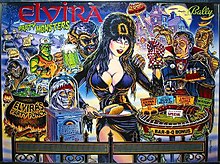
Pinball games are a family of games in which a ball is propelled into a specially designed table where it bounces off various obstacles, scoring points either en route or when it comes to rest. Historically the board was studded with nails called 'pins' and had hollows or pockets which scored points if the ball came to rest in them. Today, pinball is most commonly an arcade game in which the ball is fired into a specially designed cabinet known as a pinball machine, hitting various lights, bumpers, ramps, and other targets depending on its design. The game's object is generally to score as many points as possible by hitting these targets and making various shots with flippers before the ball is lost. Most pinball machines use one ball per turn, and the game ends when the ball(s) from the last turn are lost. The biggest pinball machine manufacturers historically include Bally Manufacturing, Gottlieb, Williams Electronics and Stern Pinball.

WMS Industries, Inc. was an American electronic gaming and amusement manufacturer in Enterprise, Nevada. It was merged into Scientific Games in 2016. WMS's predecessor was the Williams Manufacturing Company, founded in 1943 by Harry E. Williams. However, the company that became WMS Industries was formally founded in 1974 as Williams Electronics, Inc.
Baby Pac-Man is a hybrid maze and pinball game released in arcades by Bally Midway on October 11, 1982, nine months after the release of Ms. Pac-Man. The cabinet consists of a 13-inch video screen seated above a shortened, horizontal pinball table. The combination fits into roughly the same size space as an upright arcade machine. 7,000 units were produced.
A glossary of terms, commonly used in discussing pinball machines.

Steven Scott Ritchie is an American pinball and video game designer. His career began in the 1970s, Ritchie holds the record for best-selling pinball designer in history. He has been called "The Master of Flow" due to the emphasis in his designs on ball speed, loops, and long smooth shots. Ritchie was also the original voice of Shao Kahn in the Mortal Kombat fighting game series, serving as the announcer of Mortal Kombat II (1993), Mortal Kombat 3 (1995), and the updates to Mortal Kombat 3. He is the older brother of fellow pinball designer Mark Ritchie.

Cirqus Voltaire is a 1997 pinball game, designed by John Popadiuk and released by Williams Electronics Games. The theme involves the player performing many different marvels in order to join the circus. Some of the game's distinctive features include a neon light running along the right-hand ramp, a pop bumper that rises up from the middle of the playfield at certain times, and a magnet at the top of the left ramp that can catch balls and divert them into the locks. The most notable feature is the Ringmaster, a head that rises at certain times and taunts the player.

Indianapolis 500 is a pinball machine designed by Dennis Nordman and produced by Midway released in June 1995. It is based on the sporting event of the same name.
Gilligan's Island is a Midway pinball machine released in May 1991. It is based on the television series of the same name and the first Williams WPC machine that was released with a high resolution (128x32) dot matrix display. Bob Denver supplied original speech for the game which also featured the theme song from the television show. Tina Louise refused to lend her likeness and an alternate blonde character appears on the backglass of the machine.

Black Rose is a pinball machine designed by John Trudeau and Brian Eddy and produced by Midway. The game features a pirate theme and was advertised with the slogan "This game is loaded!".Bally abandoned the idea to use black pinballs for the machine.

Checkpoint is a 1991 pinball machine released by Data East. It featured the first dot matrix display (DMD) ever incorporated into a pinball game. For Checkpoint, Data East used a "half-height" DMD. By way of comparison, Williams later produced machines with standard DMDs that were twice the height. Checkpoint also features video mode minigames on its display.

Creature from the Black Lagoon is a pinball machine designed by John Trudeau and released by Midway. It is loosely based on the movie of the same name. The game's theme is 1950s drive-in theater. The pinball game was licensed from Universal Studios by Bally so that all backglass and cabinet artwork and creature depictions would resemble those of the original movie.

Scared Stiff is a 1996 pinball game designed by Dennis Nordman and released by Midway, featuring horror show-hostess Elvira. It is the follow-up to 1989's Elvira and the Party Monsters, also designed by Nordman.
The Williams Pinball Controller (WPC) is an arcade system board platform used for several pinball games designed by Williams and Midway between 1990 and early 1999. It is the successor to their earlier System 11 hardware. It was succeeded by Williams/Midway's Pinball 2000 platform, before Williams left the pinball business in October 1999.

George Gomez is an industrial designer, video game designer, and pinball designer who has worked for Bally, Williams, and Stern Pinball, among other companies. He worked on the team that created the Tron video game, and headed the team that created Spy Hunter. In 1984 after the 1983 video game crash, he left Midway to invent toys at the consulting firm Marvin Glass & Associates.

The Party Zone is a crossover solid-state pinball machine released in 1991 by Midway designed by Dennis Nordman and programmed by Jim Strompolis. It is in a single playfield format and collaborates characters from previous pinball machines. It is the second pinball machine released after the Bally-Midway division was sold, yet still operated under the "Bally" name.

Harley-Davidson was a pinball machine arcade game manufactured by Midway and released under the Bally label in February 1991. Barry Oursler and Mark Sprenger designed the pinball game utilizing the Williams Pinball Controller arcade system board platform. This was the first pinball game sold under the Bally label to use the Williams WPC system and their last to use an Alphanumeric Display.

Dr. Dude and His Excellent Ray is a pinball machine designed by Dennis Nordman and released in 1990 by Midway. The theme of the game revolves around gaining coolness.

Lost World is a pinball machine released by Bally in 1977. The game features a fantasy theme. It should not to be confused with the pinball machine Escape from the Lost World from 1987.
Bugs Bunny's Birthday Ball is a 1990 pinball game designed by John Trudeau and Python Anghelo and released by Midway. It is based on Warner Bros.' Looney Tunes and Merrie Melodies series of cartoons. This is the first of only two licensed pinball tables ever to feature the Looney Tunes characters.
Lyman F. Sheats Jr was an American pinball champion, game designer and coin-operated game operating system software engineer who had worked for Bally, Williams, and Stern Pinball, among other companies.














